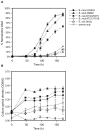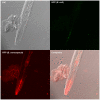Susceptibility of Caenorhabditis elegans to Burkholderia infection depends on prior diet and secreted bacterial attractants
- PMID: 19956737
- PMCID: PMC2776534
- DOI: 10.1371/journal.pone.0007961
Susceptibility of Caenorhabditis elegans to Burkholderia infection depends on prior diet and secreted bacterial attractants
Abstract
The nematode Caenorhabditis elegans may be killed by certain pathogenic bacteria and thus is a model organism for studying interactions between bacteria and animal hosts. However, growing nematodes on prey bacteria may influence their susceptibility to potential pathogens. A method of axenic nematode culture was developed to isolate and quantify interactions between C. elegans and potentially pathogenic strains of the Burkholderia cepacia complex. Studying these dynamics in liquid solution rather than on agar surfaces minimized nematode avoidance behavior and resolved more differences among isolates. Most isolates of B. cenocepacia, B. ambifaria and B. cepacia caused 60-80% mortality of nematodes after 7 days, whereas isolates of B. multivorans caused less mortality (<25%) and supported nematode reproduction. However, some B. cenocepacia isolates recovered from chronic infections were much less virulent (5-28% mortality). As predicted, prior diet altered the outcome of interactions between nematodes and bacteria. When given the choice between Burkholderia and E. coli as prey on agar, axenically raised nematodes initially preferred most lethal Burkholderia isolates to E. coli as a food source, but this was not the case for nematodes fed E. coli, which avoided toxic Burkholderia. This food preference was associated with the cell-free supernatant and thus secreted compounds likely mediated bacterial-nematode interactions. This model, which isolates interactions between bacteria and nematodes from the effects of prior feeding, demonstrates that bacteria can influence nematode behavior and their susceptibility to pathogens.
Conflict of interest statement
Figures





References
-
- Blaxter ML, De Ley P, Garey JR, Liu LX, Scheldeman P, et al. A molecular evolutionary framework for the phylum Nematoda. Nature. 1998;392:71–75. - PubMed
-
- Tan MW, Ausubel FM. Caenorhabditis elegans: a model genetic host to study Pseudomonas aeruginosa pathogenesis. Curr Opin Microbiol. 2000;3:29–34. - PubMed
-
- Aballay A, Ausubel FM. Caenorhabditis elegans as a host for the study of host-pathogen interactions. Current Opinion in Microbiology. 2002;5:97–101. - PubMed
-
- Forrester S, Milillo SR, Hoose WA, Wiedmann M, Schwab U. Evaluation of the pathogenicity of Listeria spp. in Caenorhabditis elegans. Foodborne Pathog Dis. 2007;4:67–73. - PubMed
Publication types
MeSH terms
Substances
LinkOut - more resources
Full Text Sources
Molecular Biology Databases
Research Materials

